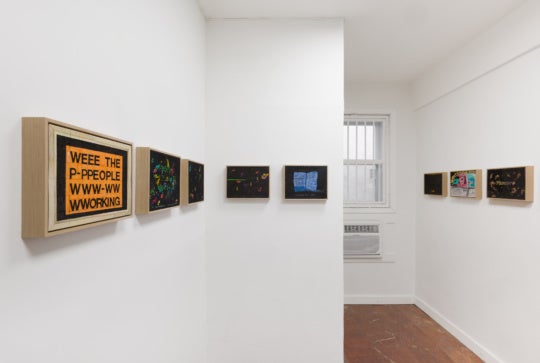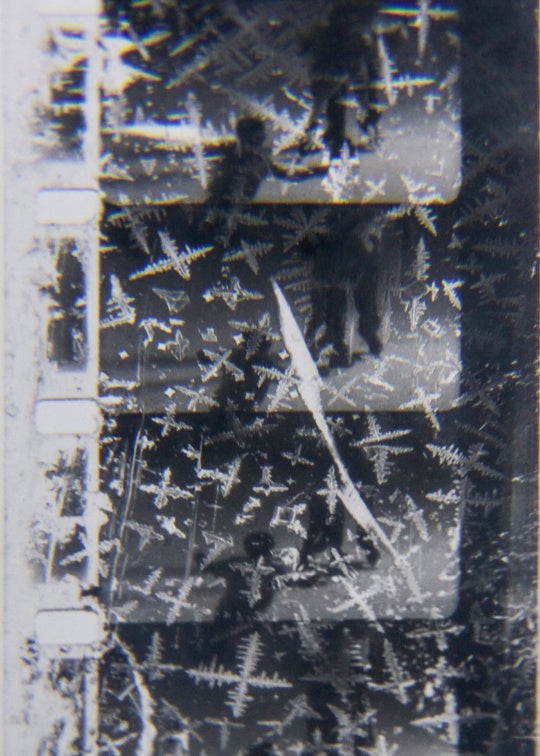
Chinese dissident artist and graduate of the Beijing Film Academy Ai Weiwei’s documentary about the immigration crisis, Human Flow, unfolds with a somnambulist’s halting rhythm, a waking nightmare of ceaseless journeying and little hope of rest. Opening today at Landmark Midtown Art Cinema, the film chronicles a reality that’s hard to imagine, a stateless limbo in which a home defined by conflict, persecution and poverty is replaced by a rootless, nomadic state, a condition of terminal wandering or waiting.

Human Flow’s attitude suggests a blend of documentarian Hubert Sauper’s dystopian state of things in films like Darwin’s Nightmare about the ruinous global trade routes that reduce the Third World to the exploited and the First World to exploiters, the beauty-in-horror photographs of Sebastião Salgado, and Edward Burtynsky’s Manufactured Landscapes, in which antlike masses of people play out a theater of contemporary global interconnection. Not since WWII has the world seen such a massive migration of people, Human Flow instructs, and it happens increasingly with an absence of compassion, and sometimes downright hostility. Human Flow is, like any socially conscious artist’s mission, a corrective to that apathy.
Rather than locating the immigration crisis in one place or among one group, Human Flow focuses on its devastating global scale, and includes stateless Palestinians living in what amounts to an open-air prison, Syrian refugees, the Rohingya, Somalians and Mexicans. The film travels through 23 countries in total, often moving between the journey itself — as Syrian refugees arrive on the Greek island of Lesbos, for example— to their countries of origin. At times a scroll appears on the bottom of the screen like a newsfeed with headlines from European newspapers testifying to the extent of the crisis. Such moments of pragmatism are coupled with the more lyrical perspective of international poets and thinkers reflecting on the universality of immigration and the gnawing placelessness of the immigrant experience.
The images are heart-wrenching and the scale of loss inconceivable. A man openly weeps over the fresh dirt mounds of a remote graveyard that holds his drowned family members. There is a consuming despair and hopelessness at not just the horrors that have been witnessed but the indignities of these immigrants’ ongoing limbo.
The footage Ai Weiwei captures in Human Flow can be surreal and disconcerting. Oftentimes, unlike the huddled Others of a politically and media-generated imagination, the migrants wear puffer jackets and backpacks and branded sportswear and could be residents of any big city heading out in cold weather for a baguette at the grocer or to pick up a child from school. It’s hard not to put yourself in their place. But instead, these contemporary global citizens live out of tiny pup tents by trash-filled railroad tracks, or sleep in Berlin airplane hangers—cleaner and dryer but with the feel of holding pens. Such scenarios can feel like Austrian filmmaker Michael Haneke’s contemporary morality plays Code Unknown and Cache in which First and Third worlds collide and the splendor of the West is kept behind glass, like an expensive, untouchable bauble. But in this case it’s barbed wire or checkpoints or an armed and hostile military policing the borders that keep migrants from making their way through Bulgaria or Macedonia into Western Europe or from Calais, France, into England.
“No one leaves their country lightly” says an Afghan woman, attesting to the rigor of the psychologically and physically grinding feat immigrants undertake, as she learns that the border out of Greece has been closed. In one passage of Human Flow an enormous wave of Syrians moves through Greece, only to discover Macedonia has locked down its borders and they are trapped, unable to move forward. Ai shows that the impulse to deny and stifle is not unique to Europe; the parallel American wall-building on its Southern border implicates us as well in the grave refugee crisis swelling at international borders. Ai’s next film is slated to focus on the U.S. border.

As he does with his art, Ai considers the destructive power of globalism, capitalism and authoritarianism, and its ability to crush humanity in its apparatus. His artwork, such as the piece dealing with the deaths of over 1,500 Chinese schoolchildren in the Sichuan earthquake because of poorly built schools, takes power structures to task and shines a light on what we would rather not see.
Ai’s film, like his art, moves in contrapuntal stanzas between showing the scale of the immigration crisis and its individual victims. As it reflects the circumstance of an individual within a massive whole, Ai’s film moves consistently in and out. As with his artwork, in which hundreds of children’s backpacks or mounds of rebar or refugees’ life vests or ceramic sunflower seeds are used to represent the grand scale of individual loss and personhood, we move between awe and intimacy, a sense of abstraction and identification with the victims.
At some moments, Ai adopts an overhead God’s eye view: the world becomes a tapestry of displacement in drone shots of the abstracted human condition, in row upon row of refugee tents or children set against a desert landscape like lone satellites in a vast cosmos. And then, he moves to the micro, and a woman who talks about her aimless wandering for 60 days with her young son. But she is unable to continue with her story before breaking down in wracking heaves, as if the recounting of her trauma has caused her guts to pour out. Ai leaves her side to find tissues and a bucket like a nurse ministering to her pain. In another segment in which Ai again captures his subject from behind to afford them some privacy, a man recounts the smugglers who dragged his fellow female refugees into the woods beyond their camp to rape them. What could they do? The men had guns.
Ai catalogues the process of immigrants’ dehumanization — robbed of their singularity and reduced to a faceless mass. African refugees disembarking from flimsy, overloaded rubber boats in Italy are processed in assembly-line fashion, attesting to the scale of the crisis. They are routinely wrapped like pieces of candy in thin Mylar blankets and hustled through entry points like cattle. Ai strives to restore their humanity, having subjects stand motionless as he films them, to allow us to contemplate their divine individuality. In one of the film’s lighter moments, he exchanges passports with a Syrian refugee, joking that Ai’s country of origin is both a privileged reality but also no refuge at all – he too is borderless and cast out, a political refugee himself based in Berlin, who has suffered arrest and confinement, beatings and harassment.
Ai’s impressionistic look at the immigration crisis is a gut punch of reckoning with our cosseted and buffered-by-prosperity reality. The various tragedies of our global coexistence that Human Flow documents — climate change, famine, enormous economic divides, conflict, persecution — will soon force all of us to reckon what greed, war and injustice have wrought.

Steeped in both compassion and Ai’s impish and empathetic tendency to position himself as a player in this world theater rather than a mere observer, Human Flow is informed by the very different vantage of an artist from a traditional director. Ai pretends no journalistic impartiality or documentarian neutrality but inserts himself into the flow both literally and figuratively, popping up as a character in his own film, grilling meat on an open-air cooktop, having his hair cut in a camp, sitting in on a Jordanian strategy meeting on migrants or moving in and out of the flow of Syrian refugees. “I understand them,” he says in production notes for the film, “Like me, they are also afraid of the cold and don’t like standing in the rain or being hungry. Like me, they need a sense of security.”
Human Flow makes clear that Ai relates, as another displaced person, persecuted himself as an artist in contemporary China, who’s had to escape to Europe to live and create freely. He doesn’t presume to be an anonymous observer.
At its heart, Human Flow argues that immigration is a story about the world’s haves and have nots, and people struggling to leave lives of poverty and perpetual hardship for the glittering promise of the West. It is at its foundation an economic struggle as global warming and conflict and other factors contribute to the untenability of surviving in one half of the world while the other half glitters as a beacon of promise, escape and hope.
Felicia Feaster is a managing editor at HGTV and Travel Channel, the co-author of Forbidden Fruit: The Golden Age of the Exploitation Film, and writes frequently about art and culture for a number of Atlanta and national publications. She is also a new BURNAWAY board member.




